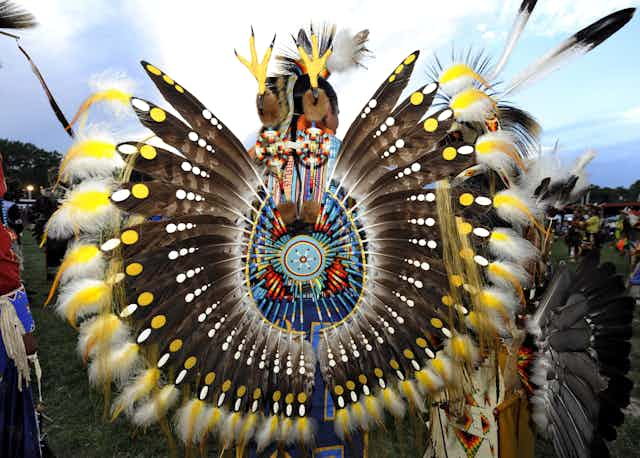Australia is being held back by its unresolved relationship with its Indigenous population. Drawing on attempts at reconciliation overseas, this series of articles explores different ways of addressing this unfinished business. Today, we turn to the United States to see how Native Americans fare.
Just like Australia’s Aboriginal and Torres Strait Islander peoples, Native Americans have struggled for recognition of the violence done to them through colonisation and the persistent harms of settler colonialism. Recognition of this fact has given rise to various policies and programs that can be grouped together under the rubric of “reconciliation”, whether or not they bear that label.
The key difference between Australia and the United States with regard to reconciliation rests on the recognition of Indigenous sovereignty. Treaties were negotiated with some hundreds of Native American tribes, and tribal sovereignty is recognised in the US Constitution.
Neither form of recognition exists in Australia. No treaties were negotiated with Aboriginal or Torres Strait Islander peoples. Debate about how they might be recognised in the Australian Constitution is ongoing.
Contemporary Native American nations, on the other hand, invoke their treaty relationships as an assertion of sovereignty that allows them to claim a “nation-to-nation” relationship with the federal government.
Despite significant shortcomings in the negotiation, content and subsequent honouring of treaties – and although the recognition of native sovereignty and treaty rights don’t match the aspirations articulated by representative bodies, such as the National Congress of American Indians – treaties continue to define the nature of the relationship between most Native Americans and the US.
Definite steps forward
The power of native treaty rights is reinforced by the significant recognition of the nation-to-nation relationship between Indian tribes and the federal government contained in the US Constitution. Article 1, section 8, clause 3, which relates to the powers of Congress, says:
The Congress shall have Power … To regulate Commerce with foreign Nations, and among the several States, and with the Indian Tribes.
This clause is widely interpreted as recognising a form of enduring sovereignty, given the other entities acknowledged in it are US states and foreign nations. And it has provided important benefits to many native peoples. It’s evident, though, that there are differing levels of capacity to leverage these benefits among the 566 federally recognised tribes.
Despite continuing legal arguments about whether native nations should be understood as “domestic dependent nations”, or part of a system of “constitutional trifederalism” (where tribes are understood as constitutionally recognised sovereigns, along with the states and federal government), there’s little dispute that Indian tribes have a degree of legal recognition as sovereigns.

The existence of treaty relationships and constitutional recognition of tribal sovereignty are further buttressed by the 1975 Indian Self-Determination and Education Assistance Act. This allows the Bureau of Indian Affairs, the government department responsible for managing relationships with Native Nations, to contract services to the tribes themselves for implementation. The significance of this has been profound.
In the decades since 1975, many tribes have taken advantage of the self-determination policy to actually exercise sovereignty. Today, many control their own schools, health services and criminal justice systems.
Historian Charles F. Wilkinson argues that the “Indian revival” that’s resulted should be regarded as comparable to the transformations of the civil rights era.
Certainly, the blossoming of effective tribal self-government in the US is being eagerly watched by Indigenous peoples in other parts of the world, who are hoping to replicate this extraordinary success.
And some steps back
Despite these advances in political reconciliation between Native Nations and the US government, there’s one area of the settler-Indigenous relationship where the US lags considerably.
Like Australia and Canada, the US subjected Native American people to the systematic removal of children from their families with the intention of eradicating their culture and inculcating them into settler ways of life. And, as in Canada, these children were primarily placed in boarding schools, where many suffered appalling abuses.
Also like both Australia and Canada, the US government has made a formal apology for these practices. But the Apology to Native Peoples of the United States has never been read aloud by any elected official.
Instead, it was signed into law by President Barack Obama, buried on page 45 of the 67-page Defense Appropriations Act 2010. The act is primarily concerned with the purchase of weapons and its signing was closed to the public. What’s more, there was no official White House announcement about it.
In the absence of wider acknowledgement of the harms suffered during the time children were being separated from their families, the National Native American Boarding School Healing Coalition is leading calls for healing and reconciliation for survivors of the boarding school system.
This struggle, at least, is familiar to Australia.
But as the Harvard Project on American Indian Economic Development continues to document the successes of tribal governments, while Australian efforts to “close the gap” on Indigenous disadvantage deliver little good news, it’s clear the pathway to meaningful reconciliation in Australia lies not in the continued paternalism of policies such as the Northern Territory Intervention (now known as Stronger Futures) but in political transformations that recognise enduring indigenous sovereignty and lead to genuine self-determination.
This is the fourth article in our series on efforts towards indigenous reconciliation in settler countries around the world. Look out for more snapshots of other countries’ progress in the coming days.

